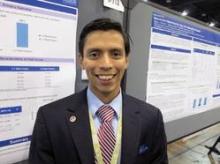DENVER – A four-variable risk score predicted acute kidney injury with high specificity in patients receiving vancomycin, results from a single-center study demonstrated.
During a poster session at the annual Interscience Conference on Antimicrobial Agents and Chemotherapy, Joseph J. Carreno, Pharm.D., discussed findings from a study that set out to identify patients at high risk for AKI during vancomycin therapy.
"Vancomycin has been the standard therapy for infections with methicillin-resistant Staphylococcus aureus for many years," Dr. Carreno of Albany College of Pharmacy and Health Sciences and his associates wrote in their abstract. "Treatment with vancomycin can be limited by the onset of renal dysfunction, which has been associated with additional morbidity. Recently, numerous investigations have evaluated and identified multiple risk factors for acute kidney injury in patients receiving vancomycin. However, few have validated the predictive probability of only those risk factors readily available at bedside at the initiation of therapy."
In a study conducted during his infectious disease pharmacy fellowship at Henry Ford Hospital, Detroit, the researchers retrospectively evaluated the medical records of 112 adult patients who were prescribed intravenous vancomycin for any suspected or confirmed infection between January 2011 and January 2012. They excluded patients who were pregnant, had end-stage renal disease at baseline, or had an absolute neutrophil count of less than 1,000/mm3.
Four risk factors were evaluated: receiving at least 4 g of vancomycin daily or having a body weight of at least 110 kg; a history of renal dysfunction; concurrent use of intravenous vasopressors, and use of concurrent nephrotoxins.
The mean age of the 112 patients was 58 years, and more than half (54%) were male. The majority (84) had fewer than two risk factors while the remaining 28 had at least two risk factors. The most common indications for therapy were infections of the lower respiratory tract and/or skin and soft tissue (49% and 27%, respectively).
Dr. Carreno and his associates reported that the prevalence of AKI was 46%. In logistic regression analysis adjusted for the other three risk factors, the odds for the development of AKI was greatest among patients on vasopressors (odds ratio, 5.92), followed by those with a history of AKI or preexisting chronic kidney disease (OR, 2.99), those on high dose vancomycin or with a body weight of at least 110 kg (OR, 1.68), and those on nephrotoxins (OR, 1.07).
More than two-thirds of patients (68%) with at least two risk factors at baseline developed AKI, compared with 38% of those who had fewer than two risk factors at baseline. The difference was significant with a P value of less than 0.01.
The sensitivity and specificity of the four-variable prediction model were 78% and 33%, respectively, among patients with at least one risk factor, and 37% and 85% among patients with at least two risk factors.
"This is a bedside tool you can use that condenses 20 years’ worth of research into a small, four-variable score that’s clinically applicable," Dr. Carreno said in an interview at the meeting. "It takes less than 5 minutes to apply this to a patient."
He acknowledged that the study’s retrospective design was a limitation.
Dr. Carreno said he had no relevant financial disclosures.


